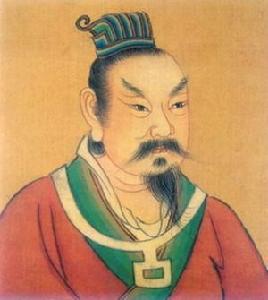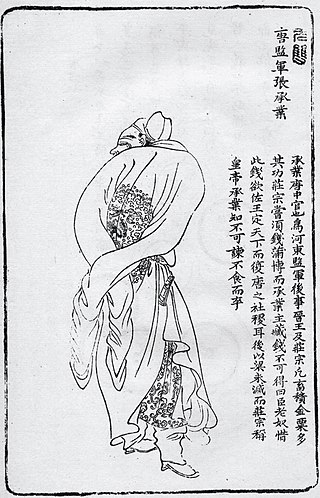Related Research Articles

Qian Liu, courtesy name Jumei, childhood name Poliu, also known by his temple name as the King Taizu of Wuyue (吳越太祖), was the founding king of Wuyue during the Five Dynasties and Ten Kingdoms period of China. He was originally a warlord of the late Tang dynasty.
Gao Jixing, né Gao Jichang (高季昌), known for some time as Zhu Jichang (朱季昌), courtesy name Yisun (貽孫), also known by his posthumous name as the Prince Wuxin of Chu (楚武信王), was the founding prince of Jingnan during the Five Dynasties and Ten Kingdoms period of China.

Emperor Taizu of Liang (梁太祖), personal name Zhu Quanzhong (朱全忠), né Zhu Wen (朱溫), name later changed to Zhu Huang (朱晃), nickname Zhu San, was a Chinese military general, monarch, and politician. He was a Jiedushi and warlord who in 907 overthrew the Tang dynasty and established the Later Liang dynasty, ruling as its first emperor, ushering in the era of the Five Dynasties and Ten Kingdoms. The last two Tang emperors, Emperor Zhaozong of Tang and Emperor Ai of Tang, who "ruled" as his puppets from 903 to 907, were both murdered by him.

Emperor Zhaozong of Tang, né Li Jie, name later changed to Li Min and again to Li Ye, was the penultimate emperor of China's Tang dynasty. He reigned from 888 to 904. Emperor Zhaozong was the seventh son of Emperor Yizong and younger brother of Emperor Xizong. Later, Li Jie was murdered by Zhu Wen, who would later become the founding emperor of the Later Liang dynasty.
Li Maozhen, born Song Wentong (宋文通), courtesy name Zhengchen (正臣), formally Prince Zhongjing of Qin (秦忠敬王), was the only ruler of the Chinese Five Dynasties and Ten Kingdoms period state Qi (901–924). He had become a powerful warlord during the reign of Emperor Zhaozong of Tang, the penultimate emperor of the preceding Tang dynasty, with his power centered on his capital Fengxiang, and at times had effective control of Emperor Zhaozong. However, his power gradually waned due to defeats at the hands of fellow warlords Wang Jian and Zhu Quanzhong. After Zhu usurped the Tang throne and established Later Liang, Li Maozhen refused to submit and continued to use the Tang-bestowed title of Prince of Qi as well as maintain the Tang era name, but his territory became even more reduced due to wars with Former Shu and Later Liang. After Later Liang was conquered by Later Tang, whose Emperor Zhuangzong claimed to be a legitimate successor of Tang, Li Maozhen submitted as a subject and was created the Prince of Qin in 924. He died soon thereafter, and was succeeded as by his son Li Jiyan as the military governor (Jiedushi) of Fengxiang, but as Li Jiyan was not made the Prince of Qi or Qin at that point, this was typically viewed as the end of Qi as an independent state.
Zhang Quanyi, né Zhang Juyan (張居言) or Zhang Yan (張言), known as Zhang Zongshi (張宗奭) during Later Liang, courtesy name Guowei (國維), formally Prince Zhongsu of Qi (齊忠肅王), was a late Tang dynasty warlord who later was a senior official during the succeeding Later Liang and Later Tang. He was credited for rebuilding the city of Luoyang from utter destruction from the warfares in the late Tang period into a prosperous city.
Empress He, formally Empress Xuanmu (宣穆皇后) as honored by Later Tang, semi-formally known as Empress Jishan (積善皇后), was the wife of Emperor Zhaozong near the end of the Tang dynasty of China, and the mother of two of his sons, Li Yu, Prince of De, and Emperor Ai. Her husband, herself, and her sons would all die at the hands of the warlord Zhu Quanzhong, who would eventually take over the Tang throne and establish his own Later Liang.
Li Yu, né Li You, briefly Li Zhen, formally the Prince of De (德王), was an imperial prince of the Chinese Tang dynasty. He was the oldest son of the penultimate emperor Emperor Zhaozong and Empress He and was crown prince from 897 to 900. In 900, Emperor Zhaozong was briefly forced by the eunuch Liu Jishu to abdicate in Li Yu's favor; after Emperor Zhaozong was restored, Li Yu was no longer Crown Prince but remained a favored son. After Emperor Zhaozong was assassinated by the powerful warlord Zhu Quanzhong in 904, Li Yu, whom Zhu was apprehensive of, was bypassed in favor of his younger brother Emperor Ai, and in 905, Zhu had Li Yu, along with eight of his younger brothers, killed. As Li Yu's brief reign was under duress from a eunuch, he is not typically considered a true emperor of Tang.
Pei Shu (裴樞), courtesy name Jisheng (紀聖) or Huasheng (化聖), was an official of the Chinese Tang dynasty, who served two terms as chancellor during the reigns of Emperor Zhaozong and Emperor Zhaozong's son Emperor Ai, near the end of the dynasty. He was killed in a purge of high-level Tang officials by the warlord Zhu Quanzhong the military governor (Jiedushi) of Xuanwu Circuit, who was then preparing to seize the throne.
Liu Can, courtesy name Zhaozhi, formally the Baron of Hedong (河東男), nicknamed Liu Qiezi, was an official of the Chinese Tang dynasty, serving as a chancellor during the reigns of Emperor Zhaozong and Emperor Zhaozong's son Emperor Ai, near the end of the dynasty.
Zhang Wenwei (張文蔚), courtesy name Youhua (右華), was an official of the Chinese Tang dynasty and Tang's succeeding Later Liang dynasty, serving as a chancellor during the reigns of Tang's final emperor Emperor Ai and Later Liang's founding emperor Emperor Taizu.

Zhang Chengye, né Kang (康), courtesy name Jiyuan (繼元), posthumous name Zhengxian (正憲), was a Chinese government official and eunuch. He originally served the Tang dynasty, but later became an important advisor to Former Jin princes Li Keyong and his successor Li Cunxu, who would later establish the Later Tang dynasty.
Li Jihui, né Yang Chongben (楊崇本), was a Chinese politician and warlord in the late Chinese Tang dynasty and early Five Dynasties and Ten Kingdoms period state Qi, who ruled Jingnan Circuit as its military governor (Jiedushi).
Li Zhen (李振), courtesy name Xingxu (興緒), was an important official of the Chinese Five Dynasties and Ten Kingdoms period state Later Liang. He was a trusted aide of Later Liang's founding emperor Emperor Taizu before the founding of the Later Liang state, and later served as the director of imperial governance during the reigns of Emperor Taizu's sons and successors Zhu Yougui and Zhu Zhen. After Later Liang was destroyed by its rival Later Tang, Later Tang's Emperor Zhuangzong put Li to death.
Luo Shaowei, courtesy name Duanji (端己), formally Prince Zhenzhuang of Ye (鄴貞莊王), was a warlord who ruled Weibo Circuit, also known as Tianxiong Circuit (天雄), as its military governor (Jiedushi), late in the Chinese Tang dynasty and early in Tang's successor state Later Liang. His rule over Weibo was originally largely independent, but toward the end of his life increasingly integrated with the Later Liang state, in large part due to his massacre of his unruly headquarters guard corps, which lessened the danger of an overthrow but also decreased the strength of the Weibo army and forced its reliance on the Later Liang state.
Yang Wo, courtesy name Chengtian, also known by his temple name as the Emperor Liezu of Yang Wu (楊吳烈祖), was the first independent ruler of the Chinese Yang Wu dynasty during the Five Dynasties and Ten Kingdoms period, reigning as the Commandery Prince of Hongnong.
Zhu Youqian, né Zhu Jian (朱簡), known as Li Jilin (李繼麟) from 923 to 926, courtesy name Deguang (德光), formally the Prince of Xiping (西平王), was a Chinese military general, monarch, politician, and warlord of the late Chinese dynasty Tang dynasty and the first two dynasties of the subsequent Five Dynasties and Ten Kingdoms period, Later Liang and Later Tang, ruling Huguo Circuit during most of that time. Both he and his family were extremely honored by Emperor Zhuangzong of Later Tang, but later, he was falsely accused of plotting a rebellion, and Emperor Zhuangzong put him and his entire family to death.
Kong Xun, known early in his life as Zhao Yinheng (趙殷衡), also having used surnames of Li (李) and Zhu (朱) early in life, was an official of the Chinese Five Dynasties and Ten Kingdoms period states Later Liang and Later Tang. He became prominent during the reign of Emperor Mingzong of Later Tang due to his alliance with Emperor Mingzong's trusted advisor An Chonghui, but later had a fallout with An, was ejected from the central government, and would not return to it toward the end of his life.
Zhao Guangfeng (趙光逢), courtesy name Yanji (延吉), formally the Duke of Qi (齊公), was an official in the late Chinese dynasty Tang dynasty and the succeeding Later Liang of the Five Dynasties and Ten Kingdoms period, serving as a chancellor during Later Liang.
Li Qi, courtesy name Taixiu (台秀), was an official of the Chinese Tang dynasty and its successor states Later Liang and Later Tang of the Five Dynasties and Ten Kingdoms period, serving as a chancellor during Later Liang.
References
- 1 2 3 4 5 Academia Sinica Chinese-Western Calendar Converter Archived 16 October 2013 at the Wayback Machine .
- 1 2 3 4 5 6 Zizhi Tongjian, vol. 265.
- 1 2 3 4 5 Zizhi Tongjian , vol. 266.
- 1 2 3 Old Book of Tang , vol. 20, part 2.
- 1 2 3 Zizhi Tongjian, vol. 264.
- ↑ 现代汉语词典(第七版)[ A Dictionary of Current Chinese (7th ed.) ]. Beijing: The Commercial Press. 2016. p. 197. ISBN 978-7-100-12450-8.
柷 chù 用于人名,李柷,唐哀帝
- ↑ Zizhi Tongjian, vol. 261.
- ↑ Zizhi Tongjian, vol. 276.
- ↑ New Book of Tang, vol. 10.
- ↑ However, after the end of Tang, the regional states Jin, Wu, and Qi continued to use Tang's Tianyou era name to show their refusal to recognize Later Liang. One can therefore also consider the end of the Tianyou era to be sometime early in 924, when Li Maozhen the Prince of Qi became a subject to Jin's successor state Later Tang and switched to Later Tang's Tongguang era.
- Old Book of Tang , vol. 20, part 2.
- New Book of Tang , vol. 10.
- Zizhi Tongjian , vols. 261, 264, 265, 266.
- 任士英 (2005) 正說唐朝二十一帝 Taipei (台北): 聯經. ISBN 978-957-08-2943-3